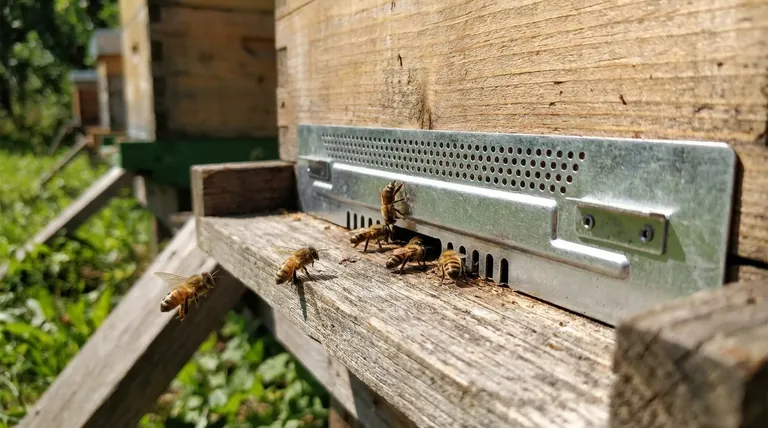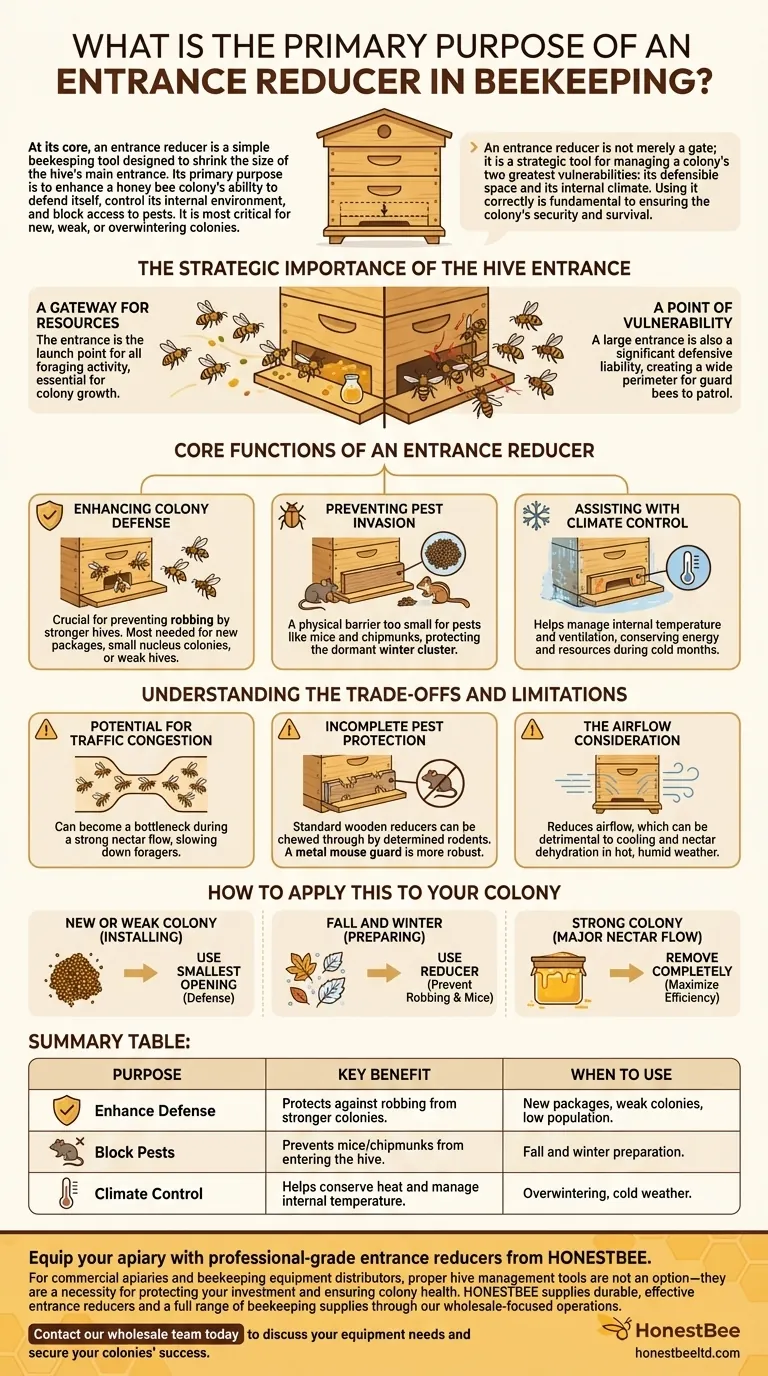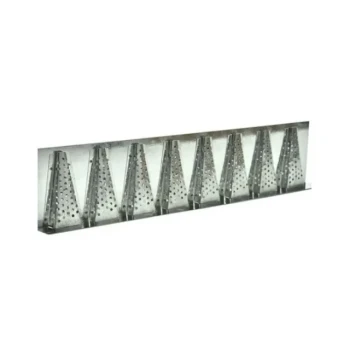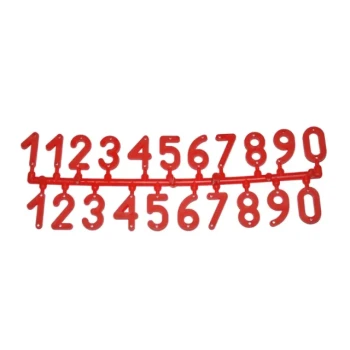At its core, an entrance reducer is a simple beekeeping tool designed to shrink the size of the hive's main entrance. Its primary purpose is to enhance a honey bee colony's ability to defend itself, control its internal environment, and block access to pests. It is most critical for new, weak, or overwintering colonies.
An entrance reducer is not merely a gate; it is a strategic tool for managing a colony's two greatest vulnerabilities: its defensible space and its internal climate. Using it correctly is fundamental to ensuring the colony's security and survival.

The Strategic Importance of the Hive Entrance
A hive's entrance is its connection to the outside world. Managing its size is a critical aspect of beekeeping that directly impacts the colony's health and productivity.
A Gateway for Resources
The entrance is the launch point for all foraging activity. Worker bees constantly travel through it to collect nectar, pollen, and water, making efficient access essential for colony growth.
A Point of Vulnerability
While vital, a large entrance is also a significant defensive liability. It creates a wide perimeter that guard bees must patrol against intruders, a task that becomes overwhelming for smaller or less populous colonies.
Core Functions of an Entrance Reducer
By physically restricting the entrance size, this simple piece of wood serves three distinct and vital functions for the hive.
Enhancing Colony Defense
A smaller entrance is far easier for guard bees to defend. This is crucial when preventing robbing, a situation where bees from stronger hives attempt to invade and steal a weaker colony's honey stores.
This defensive support is most needed for newly established packages, small nucleus colonies, or any hive with a low population.
Preventing Pest Invasion
During the fall and winter, pests like mice and chipmunks seek warm, sheltered spaces. A beehive, full of honey and pollen, is an ideal target.
An entrance reducer presents a physical barrier that is too small for these larger pests to breach, protecting the dormant winter cluster from destruction.
Assisting with Climate Control
A large opening allows heat to escape easily. By reducing the entrance size, bees can better manage the hive's internal temperature and ventilation.
This helps the colony conserve energy and resources, especially during the cold months when maintaining the cluster's warmth is critical for survival. This effect is less pronounced in hives that use screened bottom boards for ventilation.
Understanding the Trade-offs and Limitations
While essential, an entrance reducer is not a tool to be used indiscriminately. Its application requires an understanding of the colony's current needs and strength.
Potential for Traffic Congestion
During a strong nectar flow, a reduced entrance can become a bottleneck. It can slow down foragers, reducing the colony's efficiency and potentially limiting the amount of honey they can produce.
Incomplete Pest Protection
While effective against mice, a standard wooden entrance reducer can be chewed through by determined rodents. For guaranteed winter protection, a dedicated metal mouse guard is considered a more robust and reliable solution.
The Airflow Consideration
Reducing the entrance also reduces airflow. In hot, humid weather, this can be detrimental to the colony's efforts to cool the hive and dehydrate nectar into honey. The beekeeper must balance security with the need for proper ventilation.
How to Apply This to Your Colony
The decision to use an entrance reducer—and which opening size to use—depends entirely on the season and the specific state of your hive.
- If you are installing a new or weak colony: Use the smallest opening to give the small population the best defensive advantage against robbers.
- If you are preparing for fall and winter: Use the reducer to prevent robbing as nectar sources dwindle and to block mice from entering once the bees form their winter cluster.
- If your colony is strong during a major nectar flow: Remove the entrance reducer completely to maximize foraging efficiency and prevent traffic jams at the entrance.
Properly managing your hive's entrance is one of the most impactful and simple ways to support your colony's health throughout the year.
Summary Table:
| Purpose | Key Benefit | When to Use |
|---|---|---|
| Enhance Defense | Protects against robbing from stronger colonies. | New packages, weak colonies, low population. |
| Block Pests | Prevents mice/chipmunks from entering the hive. | Fall and winter preparation. |
| Climate Control | Helps conserve heat and manage internal temperature. | Overwintering, cold weather. |
Equip your apiary with professional-grade entrance reducers from HONESTBEE.
For commercial apiaries and beekeeping equipment distributors, proper hive management tools are not an option—they are a necessity for protecting your investment and ensuring colony health. HONESTBEE supplies durable, effective entrance reducers and a full range of beekeeping supplies through our wholesale-focused operations.
Let us help you strengthen your hives' defenses and boost their productivity. Contact our wholesale team today to discuss your equipment needs and secure your colonies' success.
Visual Guide

Related Products
- Beehive Entrance Reducer Guardian Metal Hive Entrance for Bees
- Multi-Functional Sliding Hive Entrance for Beekeeping
- Steel Round Disc Entrance Reducer for Flexzion Bee Hive Nuc Box Gate
- Multi-Functional Rotary Hive Entrance Disc for Beekeeping
- Professional Reversible Beehive Hive Entrance
People Also Ask
- How big should a beehive entrance be? Optimize for Colony Health & Honey Production
- What size is the entrance hole in a native bee hive? The 13mm Standard for a Thriving Colony
- How can a Langstroth hive entrance be adjusted? Mimic Natural Bee Preferences for a Healthier Hive
- What should be done after transferring frames to the new hive? Essential Steps for a Secure Colony
- What are the two functions of the Entrance Reducer? Master Hive Defense and Safe Transport



















